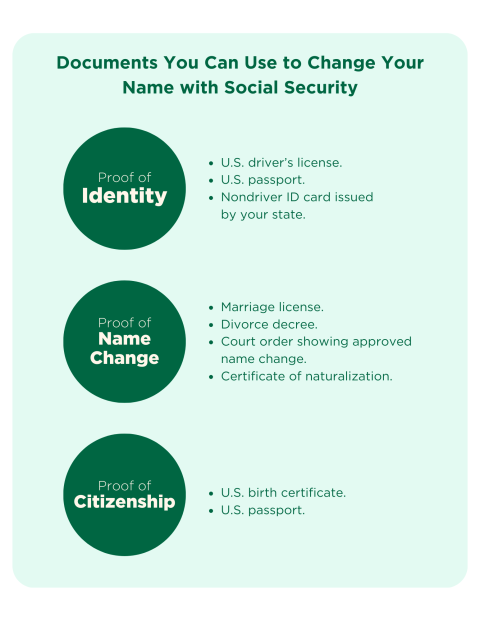How to Change Your Name with Social Security
There are three ways to request a name change on your card, and you can get a new card for free.

Many, or all, of the products featured on this page are from our advertising partners who compensate us when you take certain actions on our website or click to take an action on their website. However, this does not influence our evaluations. Our opinions are our own. Here is a list of our partners and here's how we make money.
The investing information provided on this page is for educational purposes only. NerdWallet, Inc. does not offer advisory or brokerage services, nor does it recommend or advise investors to buy or sell particular stocks, securities or other investments.
To change your name with Social Security, you need to provide proof of identity, proof of your name change and proof of citizenship. You can make the request online, fill out and mail a form or visit a local Social Security office.
Proof of identity
Because a Social Security card is a legal record, you’ll need to show proof of your identity. This type of document or record should include identifying information, such as your date of birth. The SSA also prefers that the documentation includes a recent photograph. You can use a :
- U.S. driver’s license.
- U.S. passport.
- Nondriver ID card issued by your state.
If you don’t have any of those records available or can't get a replacement within 10 days, you can ask to use a different form of ID, such as one issued by your school or employer, a health insurance card or a military ID.
🤓 Nerdy Tip
You have to bring certified original documents or certified copies. In most cases you can't provide expired documentation or photocopies. Proof of name change
You’ll need to prove to the SSA that you legally changed your name. To do so, provide documentation that shows why you’re changing your name, such as a:
- Marriage license.
- Divorce decree.
- Court order showing the approved name change.
- Certificate of naturalization with the new name .
🤓 Nerdy Tip
If you changed your name on other documentation more than two years ago, you’ll need to provide records that use your previous name. People under 18 years of age have a grace period of four years before this requirement kicks in. Proof of citizenship
If you haven’t provided proof of citizenship to the SSA before, you’ll need to provide documentation showing your citizenship status. You can use a U.S. birth certificate or U.S. passport.

There are three ways to submit a request to change your name on your Social Security card. All three use the same application.
1. Submit a request online
You can submit a request online to change your name on your Social Security card if you’re at least 18 years old and have a U.S. mailing address . The online system walks you through the process by asking you one question at a time and alerting you if any of your answers requires you to apply in person.
Once you’ve submitted your request online, you’ll need to provide proof of identity. This must be done in person at either an SSA office or a Social Security card center within 45 days of submitting your application .
Printing out the application
If you prefer to fill out a traditional form or can’t complete the online application, you can download the application and do it offline
🤓 Nerdy Tip
Consider using certified copies to avoid losing an original document if your packet is lost. Visiting a local SSA office
You can complete the entire process in person at an SSA office if you’d prefer to have someone help you. You must schedule an appointment . You can search for the nearest office at SSA.gov.
You need to keep the SSA up to date if you change your name for any reason. The following are reasons you’re likely to need a new name on your Social Security card.
- You got married and took your spouse’s last name or created a hyphenated name as a couple.
- You got divorced and want to go back to your previous name.
- You’ve been adopted.
- You don’t want to be associated with your birth or family name.
- You now identify yourself with a new name. For example, you transitioned and now identify as a different gender than what was assigned at birth.
- You had to amend or correct your birth certificate.
- You recently became a U.S. citizen.
The benefits of changing the name on your Social Security card include:
- Your government and nongovernment records will match to avoid issues with proving your identity in the future.
- Government agencies have the same name on file, which can avoid issues such as your tax refund being delayed .
- Your Social Security contributions will be correctly reported in your new name to let you claim Social Security benefits later.
But there are a few downsides to changing your name on your Social Security card:
- You have to update a lot of records, possibly including employment records, voter registration, insurance policies, utility and mortgage accounts, deeds, credit card accounts, credit reports, and doctor and pharmacy records.
- You’ll have to get new physical IDs, including your driver’s license and passport.
- If you file your taxes before your name change is complete, your tax return could be affected .
Frequently Asked Questions
How long does it take to change your name on your Social Security card?
The SSA estimates that it takes up to an hour to complete the application, but it will take up to 14 days for your application to be processed and to receive your new card in the mail.
Will I get a new Social Security number if I change my name?
No, your Social Security number will be the same after you change your name.
Will changing my name affect my eligibility for Social Security benefits?
As long as you update your name with the SSA by requesting a new card, your benefits eligibility status should remain unaffected. If you want to be certain that you’ve done everything correctly, contact an SSA office.
Article sources
NerdWallet writers are subject matter authorities who use primary,
trustworthy sources to inform their work, including peer-reviewed
studies, government websites, academic research and interviews with
industry experts. All content is fact-checked for accuracy, timeliness
and relevance. You can learn more about NerdWallet's high
standards for journalism by reading our
editorial guidelines.
- 1. Social Security Administration. Learn what documents you will need to get a Social Security Card. Accessed Oct 29, 2025.
- 2. SSA.gov. Learn what documents you will need to get a Social Security Card. Accessed Oct 29, 2025.
- 3. SSA.gov. Change Your Address and Phone Number Online with my Social Security. Accessed Oct 29, 2025.
- 4. SSA.gov. Your Social Security Number and Card. Accessed Oct 29, 2025.
- 5. Social Security Administration. Application for a Social Security Card. Accessed Oct 29, 2025.
- 6. SSA.gov. Social Security Office Locator. Accessed Oct 29, 2025.
- 4. SSA.gov. Your Social Security Number and Card. Accessed Oct 29, 2025.
- 8. USA.gov. Federal and state agencies to notify of a name change. Accessed Oct 29, 2025.
More like this
Related articles








